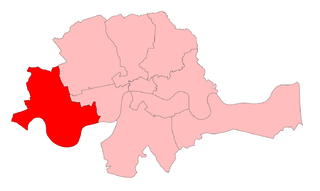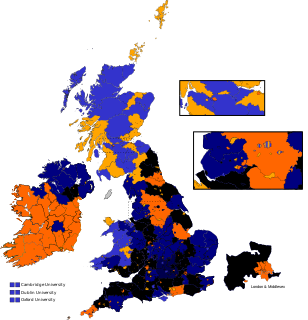Related Research Articles

South Staffordshire is a constituency represented in the House of Commons of the UK Parliament since 2010 by Sir Gavin Williamson, a Conservative.

Chelsea was a borough constituency, represented in the House of Commons of the Parliament of the United Kingdom.

South Essex was a county constituency represented in the House of Commons of the Parliament of the United Kingdom from 1832 to 1885. It elected two Members of Parliament (MPs) using the bloc vote system.

North Cheshire is a former United Kingdom parliamentary constituency. It was created upon the division of Cheshire in 1832. In 1868 it was abolished with South Cheshire to form East Cheshire, Mid Cheshire, West Cheshire and Stalybridge.
East Cheshire was parliamentary constituency which returned two Members of Parliament (MPs) to the House of Commons of the Parliament of the United Kingdom. Elections were held using the bloc vote system.
West Cheshire is a former parliamentary constituency, which returned two Members of Parliament (MPs) to the House of Commons of the Parliament of the United Kingdom.

North Derbyshire was a Parliamentary constituency in the United Kingdom constituencies. It originally returned two Knights of the Shire to the House of Commons of the Parliament of the United Kingdom.
East Derbyshire was a parliamentary constituency in Derbyshire which elected two Members of Parliament to the House of Commons of the Parliament of Great Britain and subsequently to the Parliament of the United Kingdom.

North Lincolnshire, formally known as the Northern Division of Lincolnshire or as Parts of Lindsey, was a county constituency in the Lindsey district of Lincolnshire. It returned two Members of Parliament (MPs) to the House of Commons of the Parliament of the United Kingdom.
West Staffordshire was a parliamentary constituency in Staffordshire which returned two Members of Parliament (MPs) to the House of Commons of the UK Parliament until 1885, and then one member.
South East Lancashire was a county constituency of the House of Commons of the Parliament of the United Kingdom. It was represented by two Members of Parliament. The constituency was created by the Reform act of 1867 by the splitting of the South Lancashire constituency into South-West and South-East divisions.
Manchester was a Parliamentary borough constituency in the county of Lancashire which was represented in the House of Commons of the Parliament of the United Kingdom. Its territory consisted of the city of Manchester.
North East Lancashire was a county constituency of the House of Commons of the Parliament of the United Kingdom. The constituency was created by the Reform Act of 1867 and replaced the North Lancashire Parliamentary constituency, a county division with two seats.

East Cumberland is a former county constituency in the House of Commons of the Parliament of the United Kingdom. It elected two Members of Parliament (MPs) by the bloc vote system of election.

West Kent was a county constituency in Kent in South East England. It returned two Members of Parliament (MPs) to the House of Commons of the Parliament of the United Kingdom, elected by the first past the post system.

Tower Hamlets was a parliamentary borough (constituency) in Middlesex, England from 1832 to 1885. It elected two Members of Parliament (MPs) to the House of Commons of the Parliament of the United Kingdom. It was one of the first five of its type in the metropolitan area of London. It was enfranchised by the Reform Act 1832.
EastEssex, formally known as the East Division of Essex was a parliamentary constituency in the English county of Essex. From 1868 to 1885, it returned two Members of Parliament (MPs) to the House of Commons of the Parliament of the United Kingdom, using the bloc vote system of election.

West Norfolk or Norfolk Western was a county constituency in the county of Norfolk, which returned two Members of Parliament (MPs) to the House of Commons of the Parliament of the United Kingdom, elected by the bloc vote system.
North Staffordshire was a county constituency in the county of Staffordshire. It returned two Members of Parliament (MPs) to the House of Commons of the Parliament of the United Kingdom, elected by the bloc vote system.

South Lincolnshire, formally called the Southern Division of Lincolnshire or Parts of Kesteven and Holland, was a county constituency in Lincolnshire. It returned two Members of Parliament (MPs) to the House of Commons of the Parliament of the United Kingdom, elected by the bloc vote electoral system.
References
- ↑ "Representation of the People Act 1867" (PDF). Retrieved 27 July 2017.
- ↑ "The Statutes of the United Kingdom of Great Britain and Ireland, 31 & 32 Victoria, 1867-8. The Boundary Act, 1868". London: Eyre and Spottiswoode. 1868. pp. 119–166. Retrieved 27 July 2017.
- 1 2 3 4 Craig, F. W. S., ed. (1977). British Parliamentary Election Results 1832-1885 (e-book) (1st ed.). London: Macmillan Press. p. 455. ISBN 978-1-349-02349-3.
- ↑ "The Representation of East Staffordshire" . Birmingham Daily Gazette . 10 November 1868. p. 5. Retrieved 18 March 2018– via British Newspaper Archive.
- ↑ "East Staffordshire Nomination" . Newcastle Journal . 1 August 1873. p. 3. Retrieved 21 January 2018– via British Newspaper Archive.